Thoughts on Outlive by Peter Attia MD
The purpose of this post is to review Outlive by Peter Attia MD. At a high-level, the book covers 1) the Four Horsemen, the diseases responsible for the majority of death, 2) Medicine 3.0, a proactive, holistic framework (in contrast to reactive, interventional style of current medicine), and 3) the different strategies and tactics of Medicine 3.0 to live a long healthy life. We’ll quickly cover the gist of the first two and then review some of the more interesting or applicable tactics.
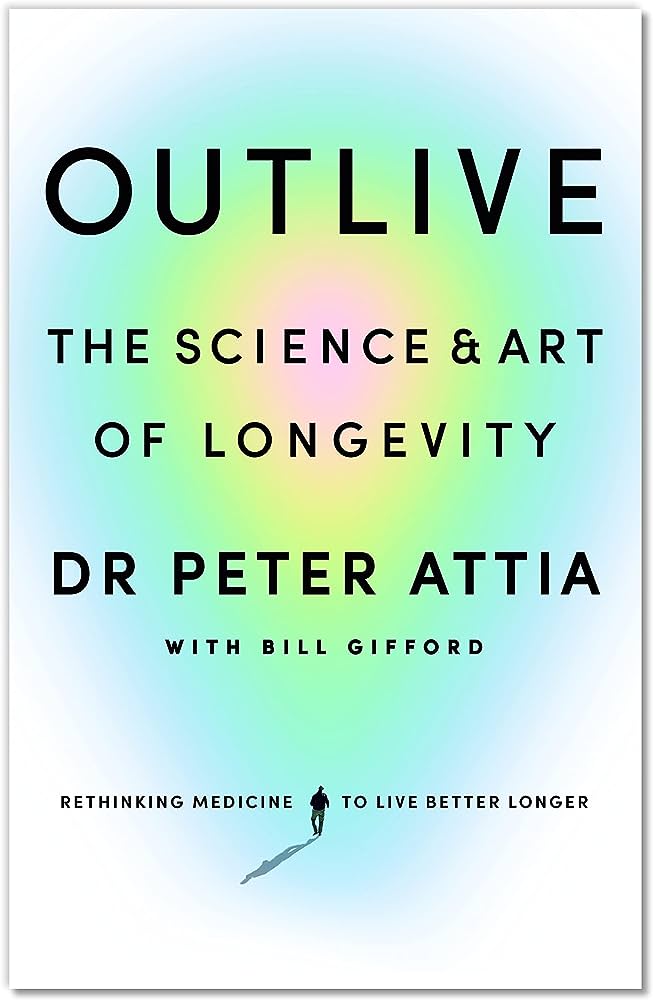
The Four Horsemen
The “Four Horsemen” represent the chronic diseases that lead to the majority of deaths, namely heart disease, cancer, neurodegenerative disease, and type 2 diabetes. These diseases start developing long before they are diagnosed. The book emphasizes that preventation and early intervention are crucial, as efforts battling these diseases (despite $$$) has largely been unsuccessful (except heart disease).
Medicine 3.0
“Medicine 3.0” in Attia’s vision emphasizes prevention rather than treatment. The focus shifts from simply extending lifespan (how long you live) to prioritizing healthspan (quality years of life). The goal is to live healthy, not simply fight off death. In order achieve a longer healthspan, he suggests a strategies and tactics different than current medicine (reactive, drugs + procedure based).
Objective, Strategy and Tactics
The book defines objectives as goals, strategies as the approaches to achieve those goals, and tactics as the specific actions taken. For longevity, the objectives are clear - maximizing healthspan and reducing the risk of the Four Horsemen. The recommended strategies are composed of exercise, nutrition, sleep, and emotional health. Finally, tactics include specific exercises, dietary guidelines, proper sleep hygiene, self-care practices, monitoring, etc.
Takeaways
Get Tested for ApoB!
The vascular system is like a 60,000 mile network responsible for transporting nutrients, waste, and cholesterol between cells. Cholesterol is essential for cell membranes, hormones, bile acids, etc. but since its made out of water insoluble fat, it requires lipoproteins to ferry it around.
Lipoproteins are essentially proteins/fats on the outside, cholesterol on the inside. Markers on the external protein give it a “badge” to access certain areas. The primary difference between HDL (“good”) and LDL (“bad”) lies in their protein coat - LDL has apolipoprotein B (apoB) while HDL has apoA. ApoB’s “badge” allows it to penetrate the endothelium (artery lining). If it then becomes oxidized, this can cause atheroscolerosis (build up and potentially blockage of the artery). This then causes additional inflammation and increases your risk for heart attacks.
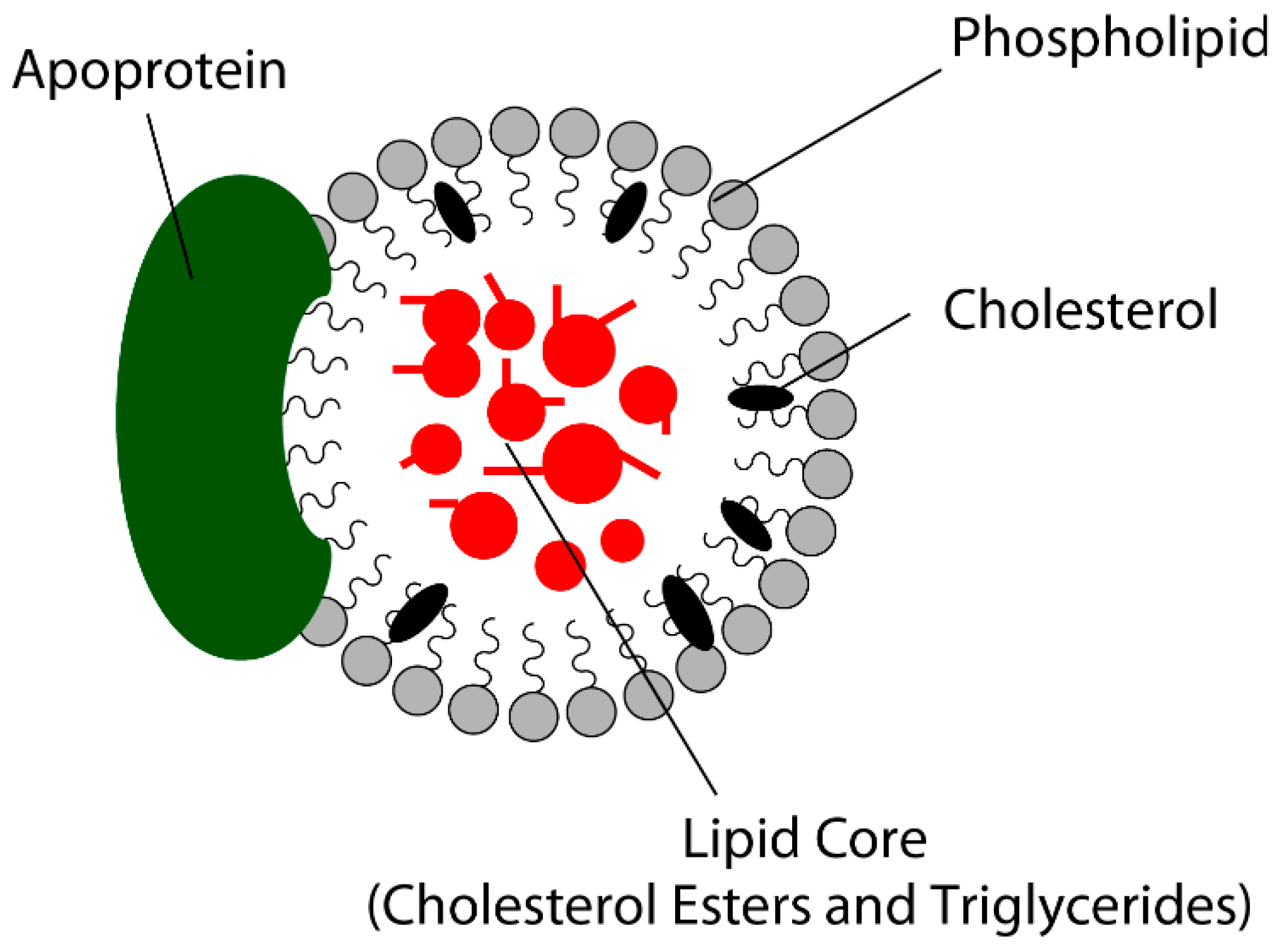
During a normal lipid panel, your doctor tests for LDL-C. While LDL-C has some signal, ApoB predicts heart attack risk much better. According to an analysis published in JAMA Cardiology in 2021, each standard-deviation increase in apoB raises the risk of myocardial infarction by 38 percent in patients without a history of cardiac events or a diagnosis of cardiovascular disease. Therefore, if you have raised apoB, you want to know as soon as possible! The book also mentions Lp(a), a subset of apoB particles that are particularly dangerous.
So next time you’re getting your yearly physical, ask them add ApoB ($14 to test) and maybe even Lp(a). Remember, whats insidious about the Four Horsemen is they progress gradually then suddenly.
Exercise > Drugs
John Ioannidis, a Stanford scientist, discovered that exercise-based interventions often outperformed or equaled pharmaceutical drugs in reducing mortality from coronary heart disease, prediabetes or diabetes, and stroke. Exercise strengthens the heart, maintains the circulatory system, enhances mitochondrial health, and boosts metabolism of glucose and fat. The benefits also extend to the body’s structural integrity, as increased muscle mass, bone density and strength provide support, functionality and protection from potential injuries.
Peter describes the 3 fitness dimensions as aerobic endurance/efficiency, strength, and stability. To improve the first dimension, aerobic endurance and efficiency, he recommends Zone 2 and Vo2 max training.
Zone 2 is lower intensity aerobic exercise. It improves metabolic flexibility, the ability to burn both fat and carbs for fuel and builds mitochondrial density and efficiency. This is important because mitochondria burn fat, produce energy, and decline with age. Therefore you want to make sure they’re running efficiently and that you have a lot of them (the mitochondria is the powerhouse of the cell!).
Vo2 max is peak aerobic capacity. Vo2 max can be improved through high intensity training, such as 3-8 minutes of near max effort. Raising VO2 max by 25% makes you functionally 12 years younger. It’s key for healthspan and lifespan.
Peter recommends 3 hours of Zone 2 and 30 minutes of Vo2 (including rest) training. Personally, I find that unrealistic as that is a lot of time. For most people its probably better to just directionally aim for some low intensity (biking, walking, jogging) and high intensity (sprints, sports) throughout the week.
Side note: Lindyman’s The Exercise Problem places Peter with Bryan Johnson (blood guy) in the “I Love Exercise Because I Fear Death” category and it totally checks out.
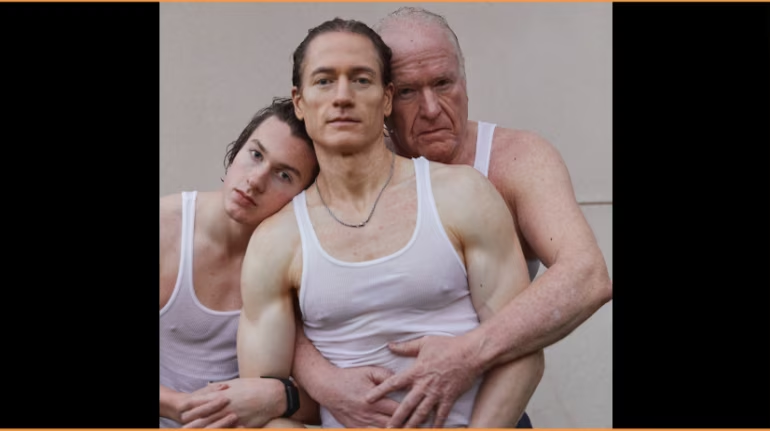
For strength and stability, Peter encourages heavy load-bearing exercises, commonly known as compound lifts. These exercises do more than build muscle. They stimulate bone growth, which is essential as both muscle mass and bone density peak in our late twenties then gradually decline. Strong muscles and bones contribute to balance and grip, critical factors in remaining independent in old age and avoiding devastating injuries like broken hips, which are often fatal to the elderly. A study of about 4,500 people aged fifty and older revealed those with low muscle mass faced a 40 to 50 percent higher risk of mortality than controls during the study.
Protein, bro?
Back in college, I worked in an emergency room and there was this one doctor bro, who’d always ask if I needed some protein, since he had some extra packed, or if I wanted to see some “pictures” that the nurses sent him. Not really related to the stuff below, but an interesting memory that bubbled up…
Anyways…starting with nutrition, to paraphrase Peter’s words, the rules of nutrition are: don’t overeat or undereat, get sufficient protein and essential fats, obtain vitamins/minerals, and avoid toxins. Much else is uncertain. This simple, non-dogmatic approach was surprising and he even stated how he’s changed his mind on many of his previous beliefs on things like ketosis, fasting, etc.
Less calories good Most people overeat. This is bad because excess calories and their downstream effects clearly contribute to metabolic disease, heart disease, cancer, and dementia. On the otherhand, calorie restriction, is one proven way to extend your life. The 3 main calorie reduction methods are: caloric restriction (CR) - just eat less; dietary restriction (DR) - dont eat certain foods (eg. paleo, gluten-free, etc); time restriction (TR) - set eating windows / fast. In his view, they’re all doors to the same room - less calories. CR is most efficacious but hard to stick to perfectly, DR works if you cut out a large enough category and TR can lead to overeating or inadequate protein and lean muscle loss.
More protein good Protein is essential for building and maintaining lean muscle mass. As mentioned above, lean muscle mass plays an important metabolic function and protects your body. It also helps you pull off harder fits. Therefore, we want to consume adequate, high-quality protein to build or maintain muscle mass.
The current guideline is 0.8g/kg. Peter believes that is too low. Instead, for active people he suggests 1-2g/kg (1g per lb) of body weight, spread over 4 servings per day. The reason for 4 servings per day is because protein is not an energy source, excess is excreted. Therefore steady spreadout intake allows more to be used for muscle synthesis (also why he has some reservations on TR).
Once again, this becomes more important as we age:
- Protein supplementation can aid the elderly in building muscle mass. A study involving strength training in sixty-two frail seniors found that those given a protein shake gained an average of about three pounds of lean mass, whereas those without supplementation gained no muscle.
- Protein helps in retaining muscle mass. The Healthy Aging and Body Composition Study, a large prospective study with over two thousand elderly subjects, determined that those consuming the most protein (18 percent of caloric intake) preserved more lean body mass over three years compared to those in the lowest quintile (10 percent of calories). The low-protein group lost 40 percent more muscle than the high-protein group.
So I hope its abundantly clear how important protein is.
Revisiting his recommendation of 1g per lb…that is a lot of protein. For someone who is 180 lbs, he suggests no fewer than 130 grams (0.72 g/lb), and ideally 180. I’m 180 pounds, so reverse engineering…first general sources of proteins I eat throughout the week
- 4 eggs ~ 24 g
- Ribeye or strip steak ~ 60 g
- Ground beef ~ 40 g
- Canned sardines ~ 22 g
- Salmon ~ 40 g
- Chicken thigh ~ 30 g
- Chicken breast ~ 40 g
- Two burger patties (costco baby!) ~ 52 g
- protein shake ~ 20 g
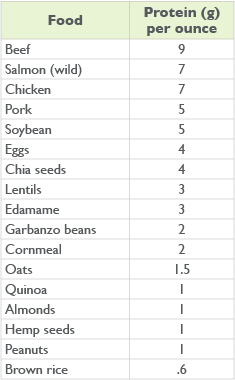
So to get in that range, I’d have to do something like 4 eggs (24) + sardines (22) + lunch with chicken breast (40) + protein shake (20) + steak (60) to get to 166. That is a lot. You can imagine how much you’d have to eat if trying to do the same with only plant protein. Even trickier is that plant protein is less bioavailable, meaning you have to overshoot it. But the main takeaway here is get your protein in bro.
Get an early cancer screening?
Early cancer detection is critical; survival rates are much higher for early-stage cancers and lower tumor burden often means a better response to treatment. The book recommends a few detection strategies:
- Stacking different modalities (mammography + MRI, PSA + other markers) to improve accuracy (kind of like ensembling in ML)
- Screening earlier than guidelines (Peter suggests a colonoscopy at 40 vs 50) to catch more cancers in time, where the risk of late screening often outweighs early false positives
- Emerging blood tests like Grail’s Galleri (Illumina), which can detect cancer before tumors are visible on scans.
One trade-off with this approach is the risk of “incidentalomas”, false positives that lead to harm (anxiety, expensive followups + procedures, etc). The Grail test is $1000, reasonably affordable. Are you willing to go all the way down the rabbit hole or just live in ignorant bliss?
Transitioning to treatments, immunotherapy is a newer cancer treatment that activates the immune system to detect and eradicate cancer cells. This includes:
- CAR T-cell therapy: T-cells are engineered to target cancer antigens and multiplied before reinfusing into the patient.
- Checkpoint inhibitors: The inhibitors block the proteins that cancers use to hide from the immune system.
- Adoptive cell therapy (ACT): Multiply and reinfuse a patient’s own T-cells to overwhelm the cancer.
- Combination therapies: Immunotherapy plus chemo or other drugs
When immunotherapy works, 80-90% of patients stay in long-term remission, unlike chemotherapy, where recurrence is common. Despite its effectiveness, current immunotherapies still only benefit a small percentage of patients, highlighting the need for further research to make them effective against a wider array of cancers.
Seed oil respector?
Vegetable or seed oils, particularly those rich in polyunsaturated fats (PUFAs), have become a significant component of modern diets. Their meteoric rise goes hand-in-hand with the decline in global health. However, based on his research, there is no conclusive evidence proving its harm. Therefore, Peter, at least for now, is not a seed oil disrespector.
Fats and free radicals:
- Saturated Fats (SFA): No double bonds between carbons; fully “saturated” with hydrogen. Solid at room temperature, stable, and linear. Common sources include butter, lard, and animal fats.
- Monounsaturated Fats (MUFA): One double bond; slightly kinked, liquid at room temperature, more prone to oxidation but still relatively stable. Extra virgin olive oil is a popular source.
- Polyunsaturated Fats (PUFA): Multiple double bonds; highly bent and flexible, liquid at room temperature, prone to oxidation. Soybean and corn oil are rich in PUFAs.
- Think of free radicals as a cult of homewreckers. They break up stable relationships, creating new homewreckers. The process then cascades on. In slightly more technical terms, free radicals, unpaired electrons, attack double bonds and free up electrons (oxidation). Anti-oxidants are healthy because they scoop up free radicals.
Rise of seed oils A century ago, we got all of our fat from animals and fruits like olives and avocados. Now thanks to heavy industrial processing, PUFA consumption via seed oils has increased by a thousand-fold since 1909! When heated, seed oil is extremely prone to oxidation. So is it to blame?
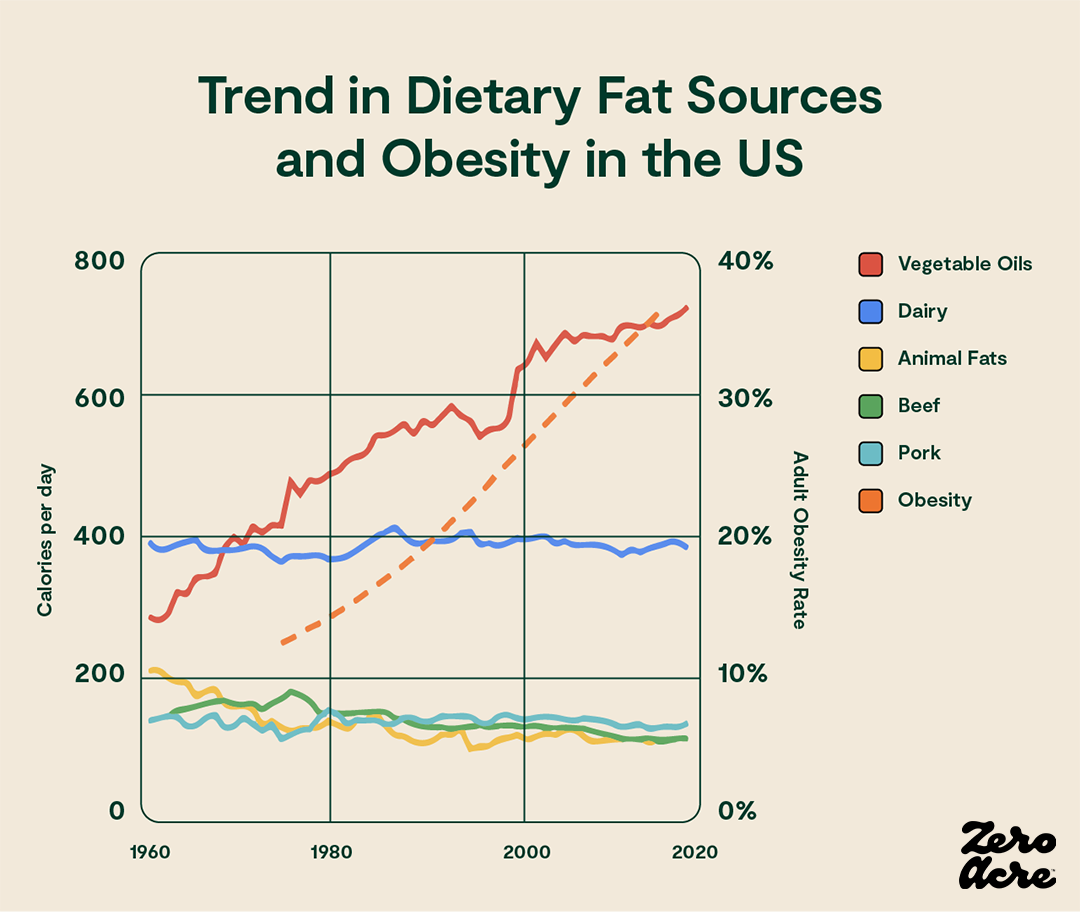
His current view is there’s no proof. Peter cites three studies:
- A comprehensive review by Cochrane Collaboration (2018) found increasing PUFA likely has a slight advantage for heart disease events but no significant impact on death risk
- A 287-page review found reduced saturated fat intake might lower cardiovascular events risk but no observed effect on mortality
- A scoping review found mainly no association between total fat, MUFA, PUFA, and SFA with the risk of chronic diseases.
Essentially there is mixed evidence, with some hinting at potential advantages or disadvantages, but nothing definitive.
So to re-summarize, the three studies say that 1) PUFAS (seed oils) may have a slight positive impact on heart disease, 2) reducing intake of saturated fat (animal fat) may have reduce cardiovascular risk, and 3) there is no association between the different fats and the risk of chronic disease.
Given mixed literature, he suggests an ideal ratio of 50-55% MUFA (eg. high quality olive oils), 15-20% SFA (eg. meats), with the rest in PUFA. He also encourages people to get lots of Omega-3s via fatty fish consumption or supplementation.
Conclusion
To summarize, the Four Horsemen are responsible for a large proportion of deaths. They happen gradually, then suddenly. We can prolong our healthspan and decrease our risk of disease through strategies such as exercise and diet. The main takeaways for me are:
- Exercise is more potent than any drug
- Don’t overeat
- Eat lots of protein, build muscle, and get a mix of zone 2 and high intensity exercise
- Get tested for lipoB, consider early cancer screenings.
Sounds simple enough ehh?